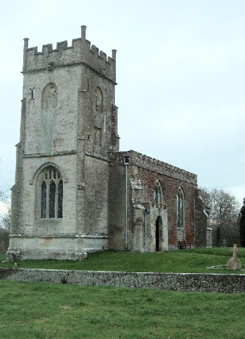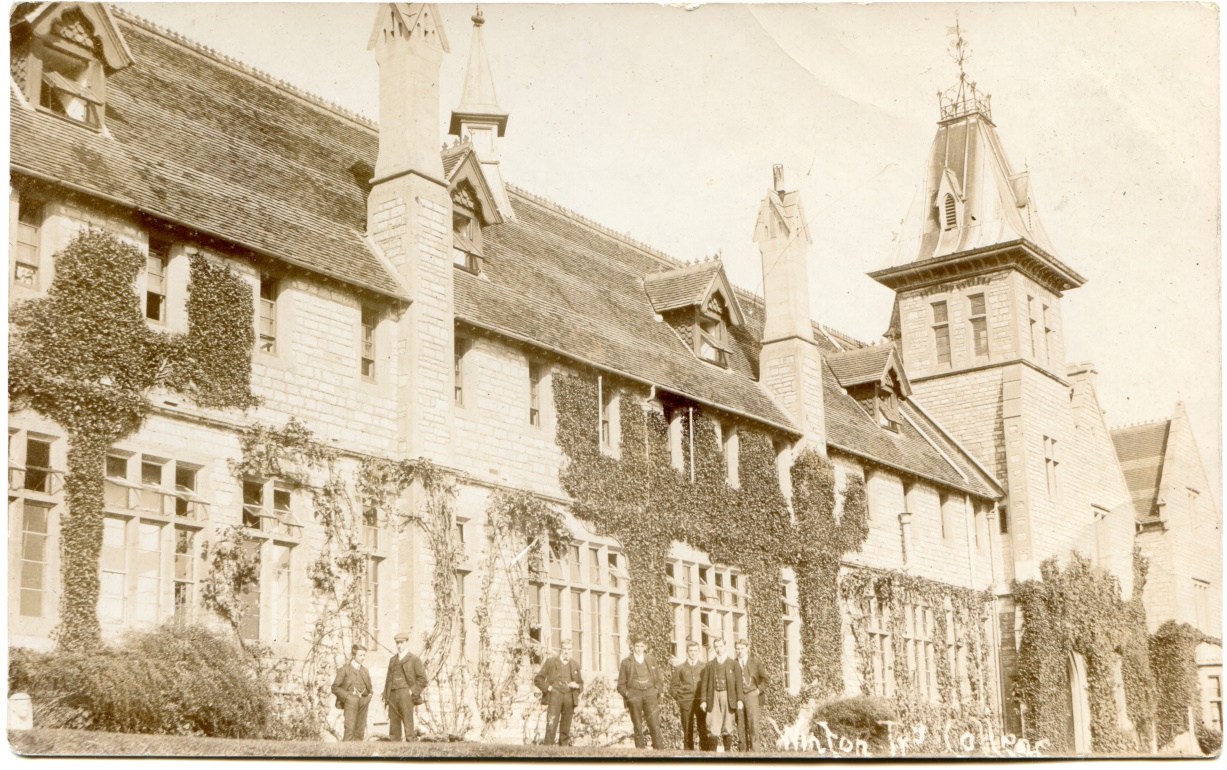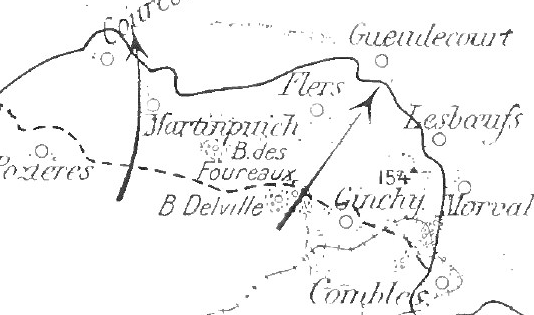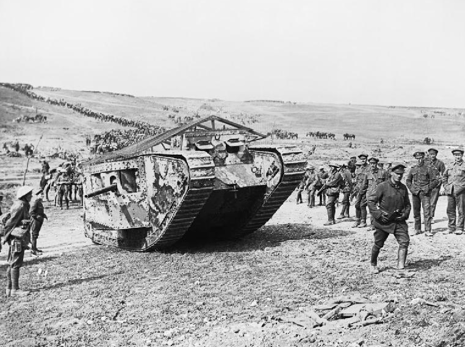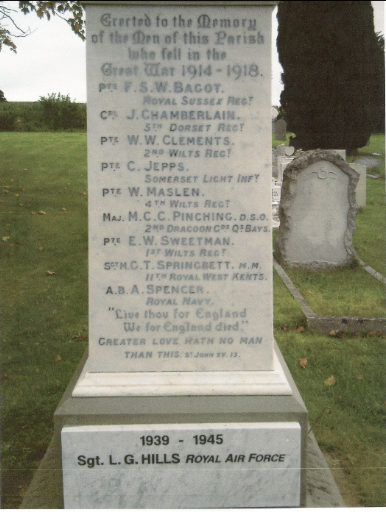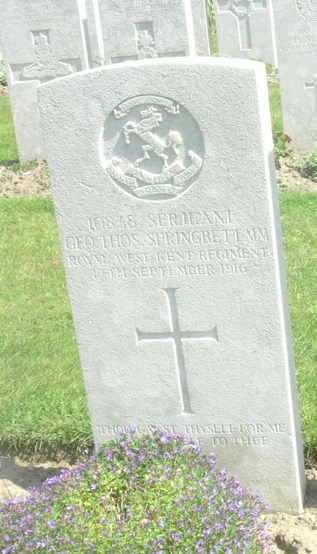George Thomas Springbett
Sergeant George Thomas Springbett MM of the Queen’s Own (Royal West Kent) Regiment, 11th Battalion, Regimental Number G/10838, died of wounds, age 34, on 17th September 1916, and is buried at Etaples Military Cemetery in France.
Early Life
George junior was the third of eight children, with two elder sisters Eleanor (1879), and Margaret (1881). After George came Annie (1884), Sydney (1886), Christopher (1888), Elsie (1892) and Alfred (1895). The 1911 census return tells us that George’s mother Anne had ten children, eight of whom survived. There is a record for the birth and death of Male Springbett’ in October of 1882, but no name has been found for him. In 1889 another child, Herbert John was born, and there is a record for his death in 1891. All of the children were born in Rushall, Wiltshire, a small village and civil parish 8 miles south-east of Devizes, one mile from Upavon, in the Vale of Pewsey. George began his formal education at Rushall National School, before becoming a pupil teacher at Steeple Ashton School in Trowbridge, Wiltshire.
By the next census of 1901 George (age 19) was living at 7, Limes Terrace, Crayford, Kent. He was working as an assistant teacher and boarding with Albert Saxby and his wife Mary and two daughters. Even though George was described as being a teacher, he had not yet been to College to do his professional training. He would have served an apprenticeship as a pupil teacher and could have then continued as an assistant teacher for as long as he wished. There were obvious advantages to undergoing a course of professional training, a better salary and job advancement prospects for example, plus many certificated teachers were provided with a schoolhouse, but the expenses incurred in going to College made it difficult for some. There was also a lot of competition for places at College and many examinations to pass .
For George’s family back in Wiltshire things had changed. By 1901 George senior was described as a farmer, and they had moved the short distance to Upavon. The second eldest daughter, Margaret was a school teacher and Sydney was employed helping his father on the farm. Ten years later Eleanor had married John Rowden Potter and moved away. Margaret was still living at home, but under her married surname of Gambling having married William Henry Clarke Gambling in 1909. Her husband was working as a grocer’s assistant in Harrow, London. Margaret is not listed as a visitor in the census, but at some point after that Margaret and William began a new life in New South Wales, Australia, where their son was born in 1916.
Winchester Training College
Winchester Training College photograph courtesy of Alwyn Ladell
In preparation for admission to Winchester Training College, George took some examinations, including Freehand and Model Drawing. He took the Preliminary Examination for the Certificate in 1903 achieving a 2nd Class pass. He was awarded a 1st Class pass in the Archbishops’ Exam for Admission.
George arrived at Winchester Training College in 1904 to begin his two year course. We have examples of George’s activities in many aspects of College life through the Wintonian magazine. He served as Sports Treasurer, and as there is no evidence that he was part of the football or cricket teams, or that he excelled at Sports’ Day we have to assume that his sporting prowess was more on the organisational side. There were regular debates reported on and George participated in one entitled Is Socialism a Remedy for Social Evils?’ The report in the Wintonian stated that although George agreed with such things as the centralisation of railways, he objected that it would entail an extra burden on an already overtaxed Parliament. He thought that the real remedy lay in the granting of equal opportunities. George was also mentioned for reciting a poem The Wiltshire Moonrakers,1 at an evening Smoker Concert’. The poem begins;
Down Vizes way zom years agoo,
When smuggal’n wur nuthen new,
An people wurden nar bit shy,
Of who they did their sperrits buy.
Hopefully the poem was delivered with an appropriately authentic Wiltshire accent!
Another important aspect of College life was the Volunteer Force that all the students were enrolled in when they first arrived at College. They learnt to shoot a rifle and George won the silver medal for the highest aggregate score in the club shooting competition.
In the Christmas exams in his first year, George was placed 4th in the year, achieving 67.5%. He maintained that level of academic achievement throughout his two years , with his lowest class position being 7th and his highest 2nd. At the end of his two years he was graded with A for Music, and B for Reading and Recitation, Drawing and Science. He was awarded first class passes in his end of year College exams and the Archbishops’ Religious Knowledge Exam. His Physical Training was noted as very good indeed.
George left College having attained the Board of Education Certificate (First Class), the Board of Education Certificate in Principles and Practice of Teaching (with distinction), and the Diploma of the Incorporated Phonographic Society. The latter qualification would have allowed George to teach shorthand and possibly also typewriting.
By the next census of 1911, a lot had happened in George’s life. He had completed his training at Winchester Training College 2 and was employed at Keeton’s Road School3 in Southwark, London. He was newly married and living at 43 Tyrwhitt Road, Brockley, in south London. He had married Lizzie Grace Shoobridge the previous year. Lizzie was described on the marriage certificate as a schoolmistress but by the time of the census no occupation was given. This was the general practice at this time, that once she was married a wife would give up her career and remain at home.
We know from his attestation papers that George continued his involvement with the Volunteer Force when he moved to London as there is a note of him having a free discharge from the Royal West Kents in 1909. In February 1913 George and Lizzie had a daughter, Joan Margaret who was born in Lewisham.
The Outbreak of War
George enlisted in the Queen’s Own (Royal West Kents) 11th Battalion, on the 8th November 1915, in Lewisham. He is recorded as being 5ft 9in tall with a chest measurement of 39 ½ in when fully expanded, with a range of 3 ½ in. He weighed 168 lb with good physical development and had been vaccinated in infancy although it was not specified which vaccinations he had been given. He had a sallow complexion with brown hair and eyes. The following day he was promoted to Lance Corporal and then to acting Corporal in December. On 10th January 1916 he became acting Sergeant, he was then made Sergeant later the same day.
The 11th (Service) Battalion was formed at Lewisham on the 5th May 1915. Catford was used as a training base and then in July 1915 they were attached to 118th Brigade in the 39th Division, but were transferred to 122nd Brigade in the 41st Division in October 1915. It was the following month that George enlisted and in January 1916 the Battalion moved to Aldershot. In May 1916 they landed in France. By the beginning of September 1916 the Battalion was billeted in Brucamps in the Somme area. The Battle of Flers-Courcelette began on the 15th September 1916. We can follow the Battalion’s preparations from the beginning of September through the War Diary.
1/09/16 Battalion training
2/09/16 Battalion training
3/09/16 Rest day (Sunday)
4/09/16 Battalion took part in Tactical Exercise (Medical)
5/09/16 Battalion training
6/09/16 Marched off from Brucamps at 3:30am to entrain at Longpre. Entrained at Longpre at 8:30am and detrained at Mericourt at 12:15pm. Proceeded by route march at 1:30pm to Albert via Dernacourt
7/09/16 Battalion training
On the 11th September the Battalion marched to a rendezvous point south west of Fricourt in preparation for the attack at Flers-Courcelette due to begin on the 15th. This was planned as a large scale renewal of the Somme offensive after weeks of fighting at Pozieres, High Wood, Delville Wood, Guillemont and Ginchy. It is a historically significant battle as it was the first in which tanks were deployed. Although few in number and mechanically unreliable the potential benefits that tanks could offer was demonstrated in this battle. Tactics for their use had yet to be fully developed but they achieved an important positive impact, partly because of the demoralising effect it had on the ordinary German soldiers. The secrecy with which the tank had been developed was successfully maintained, so they also came as a surprise to most of the allied troops. This battle also saw Canadian troops entering the fighting on the Somme for the first time. High Wood and Delville Wood were finally cleared and a deep advance made to Flers and towards Combles.
A tank at the Battle Of Flers-Courcelette
Sir Douglas Haig’s Second Despatch on the Battle of the Somme described what happened prior to the 15th September and the events of the day .
A methodical bombardment was commenced at 6am on the 12th September and was continued steadily and uninterruptedly till the moment of attack. At 6:20am on the 15th the infantry assault commenced, and at the same moment the bombardment became intense. Our new heavily armoured cars , known as Tanks’ now brought into action for the 1st time, successfully co-operated with the infantry, and coming as a surprise to the enemy rank and file gave valuable help in breaking down their resistance. The advancement met with immediate success on almost the whole of the front attacked. At 8:40am tanks were seen to be entering Flers, followed by large numbers of troops. Fighting continued in Flers for some time, but by 10 am our troops had reached the north side of the village, and by midday had occupied the enemy’s trenches for some distance beyond.
The 11th Battalion of the Royal West Kents’ War Diary describes the part they played in the events of the day.
6:20am “ The Battalion took part in the attack on Flers, being supporting Battalion to the 15th Hampshire Regiment. In this action for the first time TANKS were used in the attack. During the action Lt Col A.F. Townshend was mortally woundedBrigade re-organised at GREEN DUMP and Battalion occupied CARLTON TRENCH.
We have no evidence to tell us what happened to George on that day, but we can assume that he was wounded and transferred to the Casualty Clearing station at Etaples 45, where he died of his wounds on the 17th September 1916. He is buried in the Etaples Military Cemetery, Plot X, Row E, Grave 3A. His headstone carries the quotation, chosen by his widow;
Thou Gav’st Thyself for Me. I Give Myself to Thee
On the 8th December 1916, the London Gazette recorded that George had been awarded the Military Medal 6 for bravery in the field.
Lizzie Grace returned to live in her family home at 47 Albyn Road, St. John’s, London. It was from there that she wrote to ask for his medals. George is commemorated on the London County Council Memorial Roll and on Upavon Baptist Church memorial.
Researcher and Author: Dee Sayers
Springbetts Signature from the Students’ Register photograph by Dee Sayers
Footnotes
- The Wiltshire Moonrakers is Wiltshire’s best known folk legend which recalls how one moonlit night the men of Devizes outwitted the customs men by hiding their contraband in a pond. They then pretended they were trying to rake out a cheese, which was in reality the moon’s reflection.
- Even though he had by this time completed his professional training George was still described as an assistant teacher. Assuming he had completed his two years of training after College, he should more correctly, have been described as a certificated teacher. The term assistant teacher, however, was also used to describe a teacher who was not the Headmaster.
- Keeton’s Road School had a tragic history in WW2. Attempts to discover more about the earliest days of the school, at a time when George was teaching there, are overshadowed by its later history. The school was used as a refuge for people evacuated from their homes because of an unexploded bomb. The school itself then suffered a direct hit the following night, which resulted in considerable loss of life.
- The first medical attention that a wounded man would receive would be at a First Aid Post close to the front line. They would then be transferred by field ambulance to a dressing station and from there to a Casualty Clearing Station and finally to a base hospital.
- Etaples was a small, fishing port that during WW1 became home to huge concentrations of Commonwealth reinforcement camps and hospitals. It had the advantage of being remote from attack, except from aircraft. It was accessible by railway from both the northern and southern battlefields.
- The Military Medal was awarded to Other Ranks for bravery in the field. It was the equivalent of the Military Cross which could be awarded to Officers.
Sources
Ancestry (2018). Home page. [online] Available at: www.ancestry.co.uk [Accessed 2018].
BBC (2005). Vizes excizemen on tha scent – archived. [online] Available at: www.bbc.co.uk/wiltshire/content/articles/2005/01/13/voices_dialect_moonrakers_130105_feature.shtml [Accessed 7 December 2017].
BBC (2005). WW2 People’s War – archived. [online] Available at: http://www.bbc.co.uk/history/ww2peopleswar/stories/88/a8943988.shtml [Accessed 7 December 2017].
Commonwealth War Graves Commission, (2018). Home page. [online] Available at www.cwgc.org/ [Accessed 2018].
Find My Past (2018). Teachers Registration Council register. [online] Available at: https://www.findmypast.co.uk/ [Accessed 2018]
Imperial War Museum (2018). Upavon Baptist Church – WW1 and WW2. [online] Available at: https://www.iwm.org.uk/memorials/item/memorial/70010 [Accessed 2018].
Incorporated Phonographic Society (2018). Home page. [online] Available at: http://the-ips.org.uk/about/ [Accessed 7 December 2017].
The London Gazette. (2018). The London Gazette 8th December 1916 Supplement 29854, p.12052. [online] Available at: https://www.thegazette.co.uk/London/issue/29854/supplement/12052 [Accessed 2018].
The Long Long Trail, (2018). Welcome to the long long trail. [online] Available at: http://www.longlongtrail.co.uk/ [Accessed 2018].
Vickers, J. University of Winchester Chapel Memorial Rail image.
Wikimedia (2005). File:Rushall Church – geograph.org.uk – 87743.jpg [online] Available at: https://commons.wikimedia.org/wiki/File:Rushall_Church_-_geograph.org.uk_-_87743.jpg [Accessed 7 December 2017].
Wikimedia (2014). File:British advances during the Battle of Flers-Courcelette, 15-22 September 1916.png [online] Available at: https://commons.wikimedia.org/wiki/File:British_advances_during_the_Battle_of_Flers-Courcelette,_15-22_September_1916.png [Accessed 7 December 2017].
Wikimedia (2017). File:Tank preparing to advance at Flers-Courcelette 15-09-1916 IWM Q 5574.jpg [online] Available at: https://commons.wikimedia.org/wiki/File:Tank_preparing_to_advance_at_Flers-Courcelette_15-09-1916_IWM_Q_5574.jpg [Accessed 7 December 2017].
Wikipedia (2018). Battle of Flers Courcelette. [online] Available at: https://en.wikipedia.org/wiki/Battle_of_Flers%E2%80%93Courcelette [Accessed 7 December 2017].
Wikipedia (2018). Rushall, Wiltshire. [online] Available at: https://en.wikipedia.org/wiki/Rushall,_Wiltshire [Accessed 7 December 2017].
| University of Winchester Archive “ Hampshire Record Office | ||
| Reference code | Record | |
| 47M91W/ | P2/4 | The Wintonian 1899-1900 |
| 47M91W/ | P2/5 | The Wintonian 1901-1902 |
| 47M91W/ | P2/6 | The Wintonian 1903-1904 |
| 47M91W/ | P2/7 | The Wintonian 1904-1906 |
| 47M91W/ | P2/8 | The Wintonian 1905-1907 |
| 47M91W/ | P2/10 | The Wintonian 1908-1910 |
| 47M91W/ | P2/11 | The Wintonian 1910-1914 |
| 47M91W/ | P2/12 | The Wintonian 1920-1925 |
| 47M91W/ | D1/2 | The Student Register |
| 47M91W/ | S5//5/10 | Photograph of 5 alumni in Mesopotamia |
| 47M91W/ | Q3/6 | A Khaki Diary |
| 47M91W/ | B1/2 | Reports of Training College 1913-1914 |
| 47M91W/ | Q1/5 | Report and Balance Sheets 1904- 1949 |
| 47M91W/ | R2/5 | History of the Volunteers Company 1910 |
| 47M91W/ | L1/2 | College Rules 1920 |
| Hampshire Record Office archive | ||
| 71M88W/6 | List of Prisoners at Kut | |
| 55M81W/PJ1 | Managers’ Minute Book 1876-1903 | |
| All material referenced as 47M91W/ is the copyright of The University of Winchester. Permission to reproduce photographs and other material for this narrative has been agreed by the University and Hampshire Record Office. | ||


